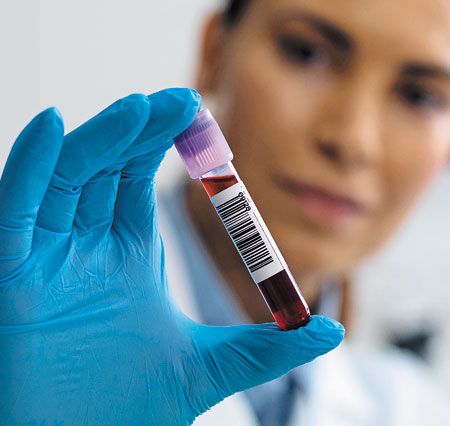Septic peritonitis: Assessing the reliability of point-of-care glucometers in diagnosis
Identification may be found in the difference in glucose concentrations between veterinary patients plasma and peritoneal fluid.

Getty ImagesWhy they did it
Previous studies have determined that if the glucose concentration of peritoneal effusion is at least 20 mg/dl lower than that of the peripheral blood, septic peritonitis is present (100% sensitivity and specificity). These studies have used peripheral blood glucose concentrations measured with a blood chemistry analyzer. In this study, researchers used a veterinary point-of-care glucometer to measure glucose concentrations for all samples since this may be more readily available in many practices. In addition, they hypothesized that glucose measurements in plasma versus whole blood may be more accurate and that increasing the cutoff value for glucose concentration differences would increase the specificity of this test for identifying patients with septic peritonitis.
What they did
Researchers evaluated blood and peritoneal fluid samples from 39 dogs presented to a veterinary teaching hospital for evaluation of peritoneal fluid of unknown cause. A veterinary point-of-care glucometer was used to measure the glucose concentration in whole blood, plasma, peritoneal fluid and peritoneal fluid supernatant samples for each patient. Septic peritonitis was diagnosed in 17 dogs based on “identification of bacteria on cytologic evaluation of peritoneal fluid, positive peritoneal fluid bacteriologic culture results, identification of a perforation in the gastrointestinal tract during surgical exploration, or necropsy confirming a septic focus.” The other 22 dogs were classified as having nonseptic peritoneal effusion; however, four were excluded due to an inability to definitively confirm or rule out the presence of septic peritonitis.
The differences in glucose concentration among whole blood, plasma, peritoneal fluid and peritoneal fluid supernatant were calculated and used to determine sensitivity, specificity, positive predictive value and negative predictive value for accurate identification of patients with septic peritonitis.
What they found
The mean glucose concentration in peritoneal fluid was 82 mg/dl for dogs with septic peritonitis and 173.8 mg/dl for dogs with nonseptic peritonitis. Values were similar between the two groups for glucose concentrations in the peritoneal fluid supernatant (mean glucose concentration of 86.1 mg/dl and 176.6 mg/dl, respectively). Peripheral packed cell volume and total protein concentrations were also similar between the two groups.
The researchers found that a difference of > 20 mg/dl between whole blood and peritoneal fluid was very specific for the presence of septic peritonitis, but sensitivity was poor (sensitivity = 41.2%; specificity = 100%). In other words, using a cutoff value of 20 mg/dl would have incorrectly identified 10 of the 17 dogs with septic peritonitis as having nonseptic peritonitis. When using this cutoff for the plasma vs. peritoneal fluid and plasma vs. peritoneal fluid supernatant samples, two of 17 dogs with septic peritonitis and three of 17 dogs with elevated peritoneal fluid supernatant glucose concentrations, respectively, would have been classified as having nonseptic effusion. Three dogs had peritoneal fluid and peritoneal fluid supernatant glucose measurements below the limit of detection of the glucometer and were correctly identified as having septic peritonitis based on all three pairings-plasma vs. peritoneal fluid, plasma vs. peritoneal fluid supernatant, and whole blood vs. peritoneal fluid.
Among dogs classified as having nonseptic peritonitis, the cutoff value of 20 mg/dl in the whole blood vs. peritoneal fluid measurements yielded accurate results for all 22 dogs. The glucose concentration difference for plasma vs. peritoneal fluid, plasma vs. peritoneal fluid supernatant, or both using this cutoff, however, incorrectly classified five of 22 dogs as having septic peritonitis, yielding a sensitivity of 88.2% and 82.4%, respectively, and a specificity of 80% and 77.8%, respectively. By increasing the cutoff value of glucose concentration difference to ≥ 38 mg/dl, however, the specificity and positive predictive value increased to 100% for both plasma vs. peritoneal fluid and plasma vs. peritoneal fluid supernatant samples.
The authors note that for dogs with severe anemia or hemoconcentration, glucose measurements using point-of-care glucometers may be affected and yield inaccurate results. Other factors such as the cellularity of the peritoneal effusion, blood pH and certain drugs may also alter these readings.
Take-home message
A glucose concentration difference of > 20 mg/dl between plasma and peritoneal fluid or plasma and peritoneal fluid supernatant may aid in the identification of patients with septic peritonitis. Using a cutoff value of ≥ 38 mg/dl increases the specificity of this test; however, fluid analysis, cytological evaluation and other clinical findings will be required to make an accurate diagnosis. The glucose difference for whole blood vs. peritoneal fluid using a point-of-care glucometer cannot reliably identify patients with septic peritonitis.
Koenig A, Verlander LL. Usefulness of whole blood, plasma, peritoneal fluid, and peritoneal fluid supernatant glucose concentrations obtained by a veterinary point-of-care glucometer to identify septic peritonitis in dogs with peritoneal effusion. J Am Vet Med Assoc 2015;247(9):1027-1032.
Link to abstract: http://avmajournals.avma.org/doi/abs/10.2460/javma.247.9.1027
Sweet pee new remedy in feline diabetes
November 9th 2023A novel class of drugs normalizes blood glucose in type 2 diabetic cats by dumping sugar into urine rather than modulating glucose uptake in the tissues but patient selection and close monitoring are crucial to using them safely
Read More